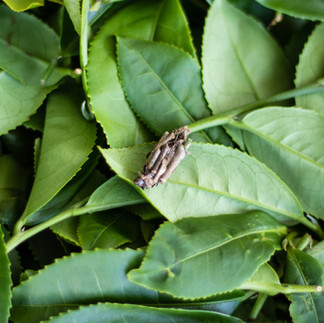
Ivy examines a freshly harvested, hand picked tea leaf. Soon, this leaf will be processed into GABA black tea.
What is GABA?
GABA is Gamma-AminoButyric Acid. GABA is a chemical that is naturally made in the brain. When taking as a supplement, it’s said that GABA can help reduce high blood pressure, and promote a general sense of well being.
What is GABA tea?
At its most simple level, GABA tea is a tea that underwent a unique processing step to allow the naturally occuring GABA found in tea to more fully express itself than traditional processing would allow. Drinking GABA tea is one of the healthiest ways to increase your GABA intake.
This tea was grown using organic agricultural methods. You can see a little caterpillar in the middle picture above.
Once harvesting is complete, the tea goes through a modified black tea production method. After outdoor withering, the tea gets loaded into a da lang (大浪)machine. Use of a da lang machine is typically reserved for the production of oolong.
However, in the processing of GABA tea, use of a da lang machine has become a common step. This is because the use of a da lang machine promotes even, and importantly, gentle partial oxidation.
Clockwise From Upper Left:
This is a da lang machine.
Ivy loads up the da lang machine with tea. This photo was taken at bout 7:30 at night.
A view of the inside of a da lang machine. Once the door is put on and secured in place, the da lang process can start.
After two and a half hours of patiently waiting, Josh and Ivy can finally unload the da lang machine.
Now that the da lang process is finished, it's time to perform the special step that will turn this into GABA tea.
This is the yan yang ji(厭氧機)machine. It is a sealed, anaerobic chamber. Removing oxygen, and introducing nitrogen, causes the tea to produce a higher level of GABA than natural processing would allow for.
The tea will stay inside the yan yang ji chamber for 12 hours. Once the tea is removed, it goes back into the da lang machine. We will repeat this cycle three times. Every time we do a cycle, the GABA level in the tea increases.
On average, traditionally produced tea has about 80mg of GABA per 100g of finished tea. When we make GABA tea, we want there to be at least 150mg of GABA per 100g of finished tea. If the finished tea has less than 150mg per 100g of tea, than it's not true GABA tea.
Once we finish three rounds of da lang and yan yang ji, we can proceed to the next processing steps.
Clockwise From Upper Left:
Ivy measures out the amount of tea to use per rolling machine. In this case, she's looking for about 13.5kg of tea per bamboo basket.
The second and third photos show off the unique, multicolored beauty of GABA tea. At this point, the leaves almost reminds us of white tea.
Ivy and Mr. Lee's father show off the beauty of this unique tea. This is the same Mr. Lee that we harvested tea with a few days ago.
From here, it's pretty much back to standard tea processing. For this GABA black tea, that means it's time to start rolling.
Clockwise From Upper Left:
First two photos show Mr. Lee loading tea into the rolling machines. As he does this, the machines continue to rotate. Without deft hands, it is very easy to get hurt doing this.
Once the tea leaves the rolling machines, it gets transferred to the drying machine.
After the tea exits the drying machine, it gets put back onto bamboo baskets.
In the last photo, we can see how drastically the form of the leaves has changed. From beautifully polychromatic, to wonderful shades of earthy browns.
As with almost all aspects of tea processing, the rolling and drying steps will be repeated as many times as necessary to produce a wonderful tea.
Want to see the finished tea? If so, please subscribe to our website. In just a few days we'll post tasting notes, and some pictures, of the finished GABA black tea. As always if you have any questions, please feel free to email us at wangfamilytea@gmail.com.
We can also be reached via our social media, links for which can be found at the top of this page.
Thank you very much for reading our blog!
From our family to yours,
The Wang Family.








































Comments